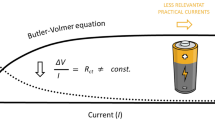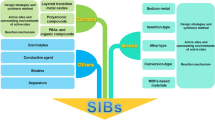Abstract
To maximize the solvent solubility and charge density of future battery systems, LiPF6 might serve as a reference standard for screening and similar analysis. This work is focused on finding a more effective electrolyte to enhance the lithium-ion battery's overall characteristics and performance such as including their toxicity, ionic conductivity, explosiveness, corrosion inhibitor, electrochemical stability and low electrolyte oxidation. Using computational tools, a solution for these kinds of issues has been evaluated. The core idea is to simulate and evaluate by changing molecular symmetries and the molecular descriptors used include non-covalent interactions, band structure, density of states, electrostatic potential, Fukui indices and others. A comparative study with other derivatives has also been carried out for comparison.
Graphical Abstract
Electrolytes evaluated model as ‘LiMF6, NaMF6 and KMF6’ where ‘M’ is N, P, As, Sb, Bi, Na, Mg, Al, Si, P, S, Cl, Ar, K, Ca, Sc, Ti, V, Cr, Mn, Fe, Co, Ni, Cu, Zn, Ga, Ge, As, Se, Br, Kr with LiM1-29F6, NaM1-29F6, KM1-29F6












Similar content being viewed by others
Data availability
On reasonable request, the data contained in this publication may be made available.
References
Xu K (2004) Nonaqueous liquid electrolytes for lithium-based rechargeable batteries. Chem Rev 104(10):4303–4418. https://doi.org/10.1021/cr030203g
Ue M et al (1997) Electrochemical properties of quaternary ammonium salts for electrochemical capacitors. J Electrochem Soc 144(8):2684–2688. https://doi.org/10.1149/1.1837882
Kawamura T et al (2002) Thermal stability of alkyl carbonate mixed-solvent electrolytes for lithium ion cells. J Power Sources 104(2):260–264. https://doi.org/10.1016/s0378-7753(01)00960-0
Koch VR (1979) Reactions of tetrahydrofuran and lithium hexafluoroarsenate with lithium. J Electrochem Soc 126(2):181–187. https://doi.org/10.1149/1.2129002
Sloop SE et al (2001) Chemical reactivity of PF5 and LiPF6 in ethylene carbonate/dimethyl carbonate solutions. Electrochem Solid-State Lett 4(4):A42. https://doi.org/10.1149/1.1353158
Xu K et al (2002) LiBOB as salt for lithium-ion batteries: a possible solution for high temperature operation. Electrochem Solid-State Lett 5(1):A26. https://doi.org/10.1149/1.1426042
Kubaib A, Imran PM, Basha AA (2022) Applications of the vienna ab initio simulation package, DFT and molecular interaction studies for investigating the electrochemical stability and solvation performance of non-aqueous NaMF6 electrolytes for sodium-ion batteries. Comput Theor Chem 1217:113934
Jin R et al (2020) Theoretical studis of photophysical properties of D−π−A−π−D-type diketopyrrolopyrrole-based molecules for organic light-emitting diodes and organic solar cells. Molecules 25(3):667. https://doi.org/10.3390/molecules25030667
Bourass M, Adil TB et al (2017) The optoelectronic properties of organic materials based on triphenylamine that are relevant to organic solar photovoltaic cells. J Chem 41(22):13336–13346. https://doi.org/10.1039/c7nj03272b
Bourass M et al (2016) DFT and TD-DFT calculation of new thienopyrazine-based small molecules for organic solar cells. Chem Central J. https://doi.org/10.1186/s13065-016-0216-6
Pauling L (1960) The nature of the chemical bond. (Vol. 260, pp. 3175–3187). Ithaca, NY: Cornell university press.
Basha AA, Khan FLA, Hussain BK (2022) Dielectric relaxation and thermodynamical parameters of hydrogen bonded complexes for Heptanamide and Pentanamide with halogenated phenols in benzene. J Mol Liq 363:119853
Parr RG, Donnelly RA et al (1978) Electronegativity: the density functional viewpoint. J Chem Phys 68(8):3801–3807. https://doi.org/10.1063/1.436185
Bögel H (1998) Über die chemische härte: chemical hardness applications from molecules to solids Von R.G. Pearson, Wiley-VCH, Weinheim, 1997. 200 S. Geb. 98.-DM. ISBN 3-527-29482-1.” Nachrichten Aus Chemie, Technik Und Laboratorium, 46(5), 550. https://doi.org/10.1002/nadc.19980460523.
Mihai VP (2011) Electronegativity and chemical hardness: different patterns in quantum chemistry. Current Phys Chem 1(2):111–139. https://doi.org/10.2174/1877946811101020111
Putz M (2008) Density functionals of chemical bonding. Int J Mol Sci 9(6):1050–1095. https://doi.org/10.3390/ijms9061050
Ghosh DC, Islam N (2011) Whether there is a hardness equalization principle analogous to the electronegativity equalization principle-a quest. Int J Quantum Chem 111(9):1961–1969. https://doi.org/10.1002/qua.22508
Srivastava A, Rawat P, Tandon P, Singh RN (2012) A computational study on conformational geometries, chemical reactivity and inhibitor property of an alkaloid bicuculline with γ-aminobutyric acid (GABA) by DFT, Comput. Theor Chem 993:80–89. https://doi.org/10.1016/j.comptc.2012.05.025
Lu T, Chen F (2012) Multiwfn: a multifunctional wavefunction analyzer. J Comput Chem 33(5):580–592
https://jp-minerals.org/en/, https://crystalexplorer.scb.uwa.edu.au
https://materialsproject.org/, ccdc.cam.ac.uk/, Crystallography.net/
Orbitals IFF (1976) Organic chemical reactions John Wiley and Sons. New York, 1976.
Rodriguez JR et al (2021) Role of the solvation shell structure and dynamics on K-Ion and Li-Ion transport in mixed carbonate electrolytes. Batteries Supercaps. https://doi.org/10.1002/batt.202100223
Chattaraj PK et al (2003) Philicity: a unified treatment of chemical reactivity and selectivity. J Phys Chem A 107(25):4973–4975. https://doi.org/10.1021/jp034707u
Koopmans T (1934) Über Die Zuordnung von Wellenfunktionen Und Eigenwerten Zu Den Einzelnen Elektronen Eines atoms. Physica 1(1–6):104–113. https://doi.org/10.1016/s0031-8914(34)90011-2
Deb, B. M. Force concept in chemistry. Van Nostrand Reinhold, 1981.
Modern Methods of Organic Synthesis/Eds. W. Carruthersa and I. Coldham. Cambridge University Press: Cambridge, England, 2004.
Pagni RM (1978) Mechanism and theory in organic chemistry (Lowry, Thomas H.; Richardson, Kathleen Schueller). J Chem Edu, 55(1), A44. https://doi.org/10.1021/ed055pa44.2.
Lin S-K (2000) Advanced organic chemistry. Part a: structure and mechanisms. Fourth Edition by Francis A. Carey.” Molecules, 5(12), 1528–29. https://doi.org/10.3390/51201528.
Domingo L et al (2016) Applications of the conceptual density functional theory indices to organic chemistry reactivity. Molecules 21(6):748. https://doi.org/10.3390/molecules21060748
Jaramillo P et al (2006) Definition of a nucleophilicity scale. J Phys Chemistry A 110(26):8181–8187. https://doi.org/10.1021/jp057351q
Ranjan P, Chakraborty T (2019) Density functional approach: to study copper sulfide nanoalloy clusters. Acta Chim Slov. https://doi.org/10.17344/acsi.2018.4762
Ndassa IM et al (2017) Understanding the reactivity and regioselectivity of [3 + 2] cycloaddition reactions between substituted nitrile oxides and methyl acrylate. A molecular electron density theory study. Int J Quantum Chem 117(24):e25451. https://doi.org/10.1002/qua.25451
Ghosh DC et al (2009) The electronegativity scale of allred and rochow: revisited. Theor Chem Accounts 124(3–4):295–301. https://doi.org/10.1007/s00214-009-0610-4
Schaller HF, Mayr H (2008) A carbocation watching in solvolysis reactions. Angew Chem Int Ed 47(21):3958–3961. https://doi.org/10.1002/anie.200800354
Chattaraj PK, Giri S (2009) Electrophilicity index within a conceptual DFT framework. Annual Rep Sect C (Phys Chem) 105:13. https://doi.org/10.1039/b802832j
Baidya M, Mayr H (2008) Nucleophilicities and carbon basicities of DBU and DBN. Chem Commun. https://doi.org/10.1039/b801811a
AlShamaileh E (2014) DFT study of monochlorinated pyrene compounds. Comput Chem 02(03):43–49. https://doi.org/10.4236/cc.2014.23006
Pérez P et al (2002) Comparison between experimental and theoretical scales of electrophilicity in benzhydryl cations. J Organic Chem 67(14):4747–4752. https://doi.org/10.1021/jo020255q
Hofacker GL (1982). Peter politzer und donald g. truhlar: chemical applications of atomic and molecular electrostatic potentials, plenum press, New York und London 1981. 472 Seiten, Preis: $ 55.-. Berichte Der Bunsengesellschaft Für Physikalische Chemie, 86(9), 872–873. https://doi.org/10.1002/bbpc.19820860925
Allred A, Rochow E (1958) A scale of electronegativity based on electrostatic force. J Inorg Nucl Chem 5(4):264–268. https://doi.org/10.1016/0022-1902(58)80003-2
Mineva T, Parvanov V, Petrov I, Neshev N, Russo N (2001) Fukui indices from perturbed kohn−sham orbitals and regional softness from mayer atomic valences. J Phys Chem A 105(10):1959–1967. https://doi.org/10.1021/jp003458w
Contreras RR, Fuentealba P, Galván M, Pérez P (1999) A direct evaluation of regional Fukui functions in molecules. Chem Phys Lett 304(5–6):405–413. https://doi.org/10.1016/s0009-2614(99)00325-5
Chamorro E, Pérez P (2005) Condensed-to-atoms electronic Fukui functions within the framework of spin-polarized density-functional theory. J Chem Phys 123(11):114107. https://doi.org/10.1063/1.2033689
Ta HQ, Zhao L, Yin W, Pohl D, Rellinghaus B, Gemming T, Rümmeli MH (2018) Single Cr atom catalytic growth of graphene. Nano Res 11(5):2405–2411
Kresse G, Joubert D (1999) From ultrasoft pseudopotentials to the projector augmented-wave method. Phys Rev B 59(3):1758
Basha AA, Ali Khan FL, Mohamed Imran P, Kubaib A (2023) Valeramide and halo-phenol in a non-polar liquid: DFT based characterization and reactivity, non-covalent interaction, and dielectric relaxation studies. Polycycl Aromat Compd. https://doi.org/10.1080/10406638.2023.2169475
Borodin O, Smith GD (2009) Quantum chemistry and molecular dynamics simulation study of dimethyl carbonate: ethylene carbonate electrolytes doped with Lipf6. J Phys Chem B 113(6):1763–1776. https://doi.org/10.1021/jp809614h
Roy S et al (2014) Carbene-dichlorosilylene stabilized phosphinidenes exhibiting strong intramolecular charge transfer transition. J Am Chem Soc 137(1):150–153. https://doi.org/10.1021/ja512089e
Basha AA, Khan FLA, Muthu S, Imran PM, Kubaib A (2023) Dielectric relaxation, dipole moment, electronic characterization and non-covalent interaction behavior of valeramide and halo-phenol in non-polar liquid: a density functional theory-based approach. J Mol Liq 370:121027
Myung ST et al (2011) Electrochemical behavior and passivation of current collectors in lithium-ion batteries. J Mater Chem 21(27):9891. https://doi.org/10.1039/c0jm04353b
Chaabene M, Zayer F, Agren S, Jabli M, Ghalla H, Baouab MHV & Chaâbane RB (2022) Use of tetraphenyl (hydroxyl) imidazole for colorimetric detection of iodide: Optical properties, computational characterizations, NBO, QTAIM and NCI-RDG analyses. Inorganic Chem Commun, 109917.
Abisha, W., Dhas, D. A., Balachandran, S., & Joe, I. H. (2022). Molecular structure, spectroscopic elucidation (FT-IR, FT-Raman, UV-Visible and NMR) with NBO, ELF, LOL, RDG, Fukui, drug likeness and molecular docking analysis on dimethomorph. Polycycl Aromat Compd, 1–44.
Author information
Authors and Affiliations
Corresponding author
Ethics declarations
Conflict of interest
There are no disputes of interest declared by all the authors and we have no conflicts of interest to disclose.
Additional information
Handling Editor: Mark Bissett.
Publisher's Note
Springer Nature remains neutral with regard to jurisdictional claims in published maps and institutional affiliations.
Rights and permissions
Springer Nature or its licensor (e.g. a society or other partner) holds exclusive rights to this article under a publishing agreement with the author(s) or other rightsholder(s); author self-archiving of the accepted manuscript version of this article is solely governed by the terms of such publishing agreement and applicable law.
About this article
Cite this article
Kubaib, A., Imran, P.M. Application of lithium and a few relevant electrolytes evaluated as secondary batteries studied using molecular descriptors, band structure and DOS. J Mater Sci 58, 4005–4019 (2023). https://doi.org/10.1007/s10853-023-08265-1
Received:
Accepted:
Published:
Issue Date:
DOI: https://doi.org/10.1007/s10853-023-08265-1




